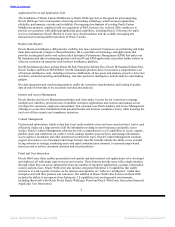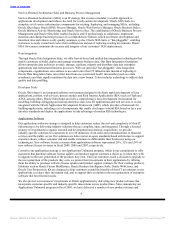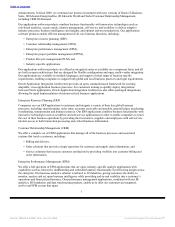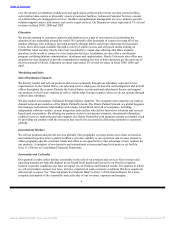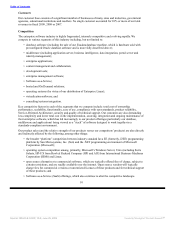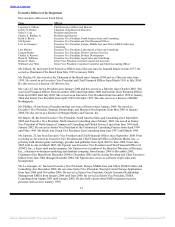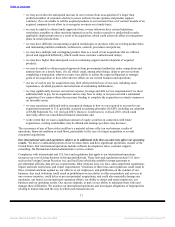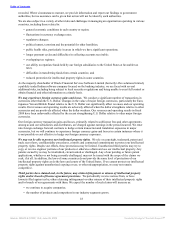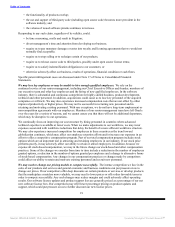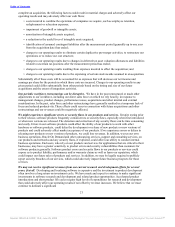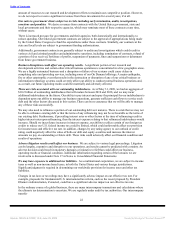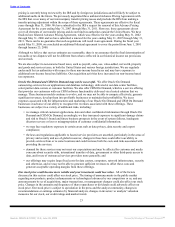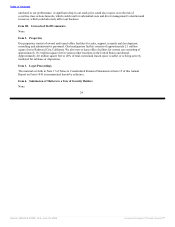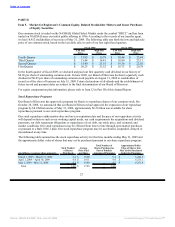Oracle 2008 Annual Report Download - page 20
Download and view the complete annual report
Please find page 20 of the 2008 Oracle annual report below. You can navigate through the pages in the report by either clicking on the pages listed below, or by using the keyword search tool below to find specific information within the annual report.
Table of Contents
In some financial markets, institutions may decrease or discontinue their purchase of the long-term customer
financing contracts that we have traditionally sold on a non-recourse basis. As a result, we may hold more of
these contracts ourselves or require more customers to purchase our products and services on a cash basis.
In addition, financial institution weakness or failures may cause us to incur increased expenses or make it
more difficult either to utilize our existing debt capacity or otherwise obtain financing for our operations,
investing activities or financing activities (including the financing of any future acquisitions and the timing
and amount of any future dividend declarations or repurchases of our common stock or our debt).
Finally, our investment portfolio, which includes short-term debt securities, is generally subject to general
credit, liquidity, counterparty, market and interest rate risks that may be exacerbated by the recent global
financial crisis. If the banking system or the fixed income, credit or equity markets continue to deteriorate or
remain volatile, our investment portfolio may be impacted and the values and liquidity of our investments
could be adversely affected.
Economic, political and market conditions can adversely affect our business, results of operations and
financial condition, including our revenue growth and profitability. Our business is influenced by a range
of factors that are beyond our control and that we have no comparative advantage in forecasting. These
include:
• general economic and business conditions;
• currency exchange rate fluctuations;
• the overall demand for enterprise software and services;
• governmental budgetary constraints or shifts in government spending priorities; and
• general political developments.
A general weakening of, or declining corporate confidence in, the global economy, or a curtailment in
government or corporate spending could delay or decrease customer purchases. In addition, terrorist attacks
around the world, the wars in Afghanistan and Iraq and the potential for other hostilities in various parts of the
world, potential public health crises and natural disasters continue to contribute to a climate of economic and
political uncertainty that could adversely affect our results of operations and financial condition, including our
revenue growth and profitability. These factors generally have the strongest effect on our sales of new
software licenses and related services and, to a lesser extent, also affect our renewal rates for software license
updates and product support.
We may fail to achieve our financial forecasts due to inaccurate sales forecasts or other factors. Our
revenues, and particularly our new software license revenues, are difficult to forecast, and, as a result, our
quarterly operating results can fluctuate substantially. We use a “pipeline” system, a common industry
practice, to forecast sales and trends in our business. Our sales personnel monitor the status of all proposals
and estimate when a customer will make a purchase decision and the dollar amount of the sale. These
estimates are aggregated periodically to generate a sales pipeline. Our pipeline estimates can prove to be
unreliable both in a particular quarter and over a longer period of time, in part because the “conversion rate”
or “closure rate” of the pipeline into contracts can be very difficult to estimate. A contraction in the
conversion rate, or in the pipeline itself, could cause us to plan or budget incorrectly and adversely affect our
business or results of operations. In particular, a slowdown in IT spending or economic conditions generally
can unexpectedly reduce the conversion rate in particular periods as purchasing decisions are delayed,
reduced in amount or cancelled. The conversion rate can also be affected by the tendency of some of our
customers to wait until the end of a fiscal period in the hope of obtaining more favorable terms, which can
also impede our ability to negotiate and execute these contracts in a timely manner. In addition, for newly
acquired companies, we have limited ability to predict how their pipelines will convert into sales or revenues
for one or two quarters following the acquisition, and their conversion rate post-acquisition may be quite
different from their historical conversion rate.
A substantial portion of our new software license revenue contracts is completed in the latter part of a quarter
and a significant percentage of these are large orders. Because our cost structure is largely fixed in the short
term, revenue shortfalls tend to have a disproportionately negative impact on our profitability. The number of
large new software license transactions also increases the risk of fluctuation in our quarterly results because a
delay in even a small
15
Source: ORACLE CORP, 10-K, June 29, 2009 Powered by Morningstar® Document Research℠


